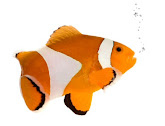Common New Aquarium Mistakes
I've been talking to several people who have an interest in starting a new fish tank. Having tanks my whole life, I've learned from my mistakes. Although you can't avoid all mistakes when starting a tank, here are some of the more common problems.
Starting Too Small
In some ways, having a small aquarium is more difficult then a bigger one. When the water volume is small, key water parameters change very quickly, leaving no room for error. However, you need to find an aquarium that fits your budget and space. Just keep in mind, the bigger the tank, the less impact a mistake will have on your fish.
Adding Fish Too Soon and too fast
Any newly set up aquariums will suffer from “new-tank syndrome.” The entire reason for this is somewhat complex, but basically, there are good bacteria that grow in the tank. As fish swim and excrete wastes, these wastes turn into ammonia. The ammonia is basically removed by the “good” bacteria. Unfortunately, these bacteria need time to grown and establish naturally during the break-in cycle of a new tank. In addition, the water in a new tank hasn't stabilized yet. The water should be treated to neutralize harmful materials, and allowed to stand for several days to allow dissolved gases to escape and the pH to stabilize. Only then is it safe to introduce fish to the aquarium. For the same reason, you shouldn't add too many fish at once. Until the “good” bacterial colonies have fully established, the aquarium cannot safely support a full load of fish. Only add a couple of small hardy fish initially. Wait until both the ammonia and nitrite levels have risen, then fallen to zero, before adding more fish.
Keeping incompatible fish
New aquarium owners often choose fish that look appealing to them, without knowing their environmental needs. Some fish may fight with one another, or require very different water conditions. Either way, they should not be kept together. Before adding any fish to the aquarium, do plenty of research on the species to determine if they are compatible and work within your current water parameters including PH and water hardness.
Failure to do research
As mentioned above, it is important to know as much about the fish as possible before taking it home. Improper care of any fish will lead to death (and a waste of your money)OverfeedingThe top mistake made by all fish owners is overfeeding their fish. Fish are opportunistic and will seek food at all times. They will always appear to be begging for food. However, it is important not to feed them more then what they can consume in about two minutes. Feeding this way once or twice a day is sufficient. Uneaten food will decay in the tank causing an increase in ammonia (Ammonia will burn the gills of the fish, and could lead to fish death.Insufficient FiltrationAn aquarium filter should run all the water in the tank through it at least three times per hour. If it doesn't, you don't have adequate filtration. If in doubt about filter size, go to the next size up. You can't over-filter, but you can definitely under-filter, and the results can be harmful to your fish.
Failure to test water
When the tank is first set up, it should be allowed to run for a couple of days, then the pH, hardness, ammonia, and nitrite levels should be tested. During the startup cycle it is important to test the ammonia and nitrites often. Once the tank is well established, test the water monthly to be aware of unseen problems that may be brewing. If fish suddenly die, test the water to see if anything has changed. Failure to do water changesJust because you are filtering the water, doesn’t mean every bit of waste will be picked up by the filter. It is important to do regular water changes (about 20% of the water every two weeks is sufficient). Wastes build up in the tank that can only be removed by vacuuming the gravel and removing some of water and replacing it with fresh water.



